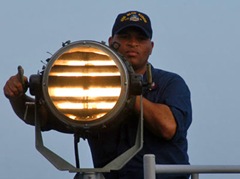 I posted a story a couple of days ago of a ham who was rescued after breaking his leg in the Cascade mountain range. He had a K1 transceiver with him and used it to call for help. By the time rescuers reached him on horseback his tent was snow covered. His skill at radio telegraphy and the skill of the operator 600 miles away is a testament to the value of good old CW. During the Vietnam War, POW Jeremiah Denton, later a U.S. senator from Alabama, blinked "T-O-R-T-U-R-E" in Morse code when his captors put him on television.
I posted a story a couple of days ago of a ham who was rescued after breaking his leg in the Cascade mountain range. He had a K1 transceiver with him and used it to call for help. By the time rescuers reached him on horseback his tent was snow covered. His skill at radio telegraphy and the skill of the operator 600 miles away is a testament to the value of good old CW. During the Vietnam War, POW Jeremiah Denton, later a U.S. senator from Alabama, blinked "T-O-R-T-U-R-E" in Morse code when his captors put him on television.
I'm rusty at CW but for the first two years of operation (1980 - 1982) I used mostly CW. The first year was with an old Apache and Comanche Heath transmitter and receiver. Had to stay away from the band edges as those old radios were a bit off in frequency. But it was fun to work CW and always wished that I had kept up those skills. I do some listening everyday on the low end of 40 meters to bring up my speed, copying in my head.
There's a free publication available in PDF format called "The Art Skill of Radio Telegraphy" 3rd edition, by William G. Pierpont, N0HFF. "It's for those who are interested in telegraphy, for those who would like to learn it, for those who love it, and for those who want to improve their skills in it."
The art and skill of telegraphy is unique. The psychologists who have seriously studied those who have developed this skill have been fascinated and challenged to try to understand it. Isn't the very idea of being able to communicate your thoughts to another by means of intermittent tones something intriguing in itself? - N0HFF
The Art And Skill Of Radio Telegraphy
There are many other helpful programs and websites for learning or brushing up on your CW skills - use Google for more information.
No comments:
Post a Comment